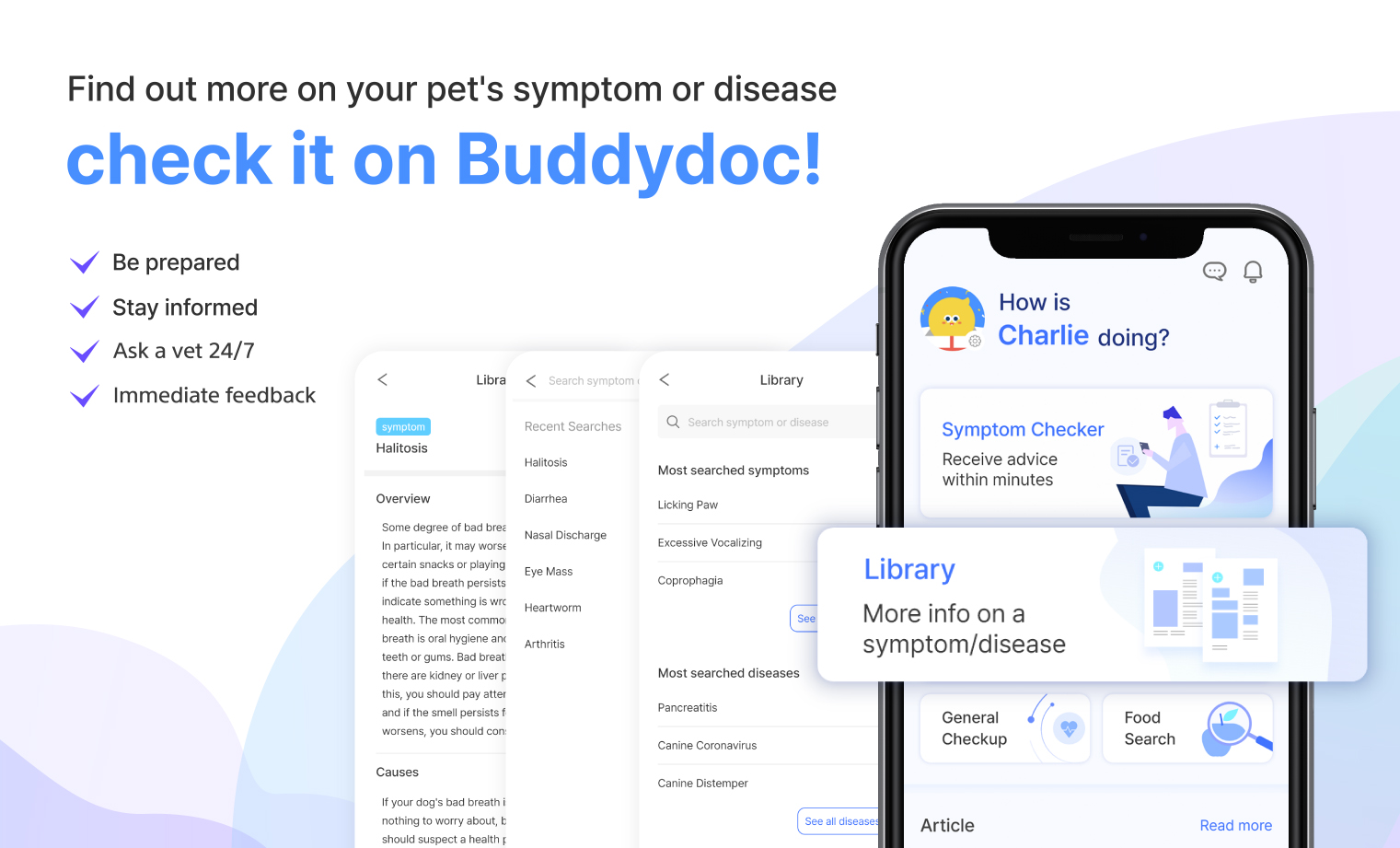DISEASES
Dog Diabetes - Symptoms, Treatment, and Care
페이지 정보
본문

What is Diabetes in Dogs?
Diabetes mellitus affects the pancreas’s ability to produce the hormone, insulin, which helps regulate the main energy source for the body’s cells. Insulin helps regulate the dog’s blood sugar levels and sends glucose to the tissues throughout the body. Without energy and proper regulation, the body resorts to finding other sources of fuel which can cause multiple health complications in dogs. Diabetes can occur in dogs at any age, but older and female dogs share a higher risk for diabetes. Typical symptoms of diabetes include increased thirst and urination, weight loss, and increased appetite. Once diagnosed, blood sugar is controlled through insulin injections, and health status is continuously monitored and managed.
What Causes Diabetes in Dogs?
There are no specific causes for diabetes; instead, the cause is more a combination of factors and at-risk variables common in dogs that develop diabetes.
Your dog may be more susceptible to diabetes if they have any of the following risk factors:
-
Breeds that are genetically predisposed to diabetes:
Australian Terrier, Standard Schnauzer, Miniature Schnauzer, Bichon Frise, Spitz, Fox Terrier, Miniature Poodle, Toy Poodle, Samoyed, Cairn Terrier, Maltese, Lhasa Apso, Yorkshire Terrier, Pug
-
Chronic pancreatitis
-
Immune-mediated destruction (IMTP)
-
Obesity or a high-fat diet
-
In heat/Pregnant
-
Cushing's disease
-
Hypothyroidism
-
On iatrogenic medication, such as glucocorticoids and progestins
What Are the Main Symptom of Diabetes in Dogs?
When insulin is insufficient, cells cannot use glucose properly, resulting in increased blood sugar levels. If this situation persists for a long time, the body, which has not been supplied with sufficient energy sources, begins to break down stored fat and protein as compensation. The response to breaking down stored fat leads to noticeable symptoms like weight loss. These bodily changes increase appetite but cause weight loss due to compensation for the lack of energy from glucose. This misregulation of glucose may overflow into the urine as well, which draws a large volume of water along with it. This is why diabetic pets drink more water to replace lost fluids and urinate more frequently.
The typical symptoms of diabetes to look out for are as follows:
- Increased thirst
- Increased urination
- Weight loss
- Increased appetite
Symptoms and complications you might also observe due to diabetes:
-
Lethargy
-
Poor hair coat
-
Muscle wasting
-
Cataracts
If diabetes is not managed for a long time, the risk of developing cataracts increases due to osmotic stress in the lens.
-
Recurrent urinary tract infection
The excretion of glucose in the urine creates an environment for bacteria to grow, making the body more susceptible to infection.
-
Ketoacidosis
When the body cannot use glucose, it uses fat and protein for fuel instead, which can cause acidosis in the body due to the formation of ketone in the bloodstream. Symptoms may include shock, coma, lethargy, anorexia, vomiting, and tachypnea. This condition is an emergency, and you must visit the hospital quickly.
-
Diabetic neuropathy
Although rare in dogs, long-term uncontrolled diabetes can result in neurological symptoms, including weakness, abnormal gait, and seizures.
-
Renal failure
Although rare in dogs, long-term uncontrolled diabetes can damage the kidneys and lead to kidney failure.
Which Dogs Are at Risk for Diabetes?
Diabetes can occur at any age but is more common in older dogs. Female dogs that are not spayed are twice as likely to develop diabetes than male dogs, and obese dogs are also at risk of developing diabetes.
When to See a Vet for Diabetes in Dogs?
It is important to recognize the symptoms of diabetes and deal with them as early as possible. Symptoms include excessive thirst, increased urination, cloudy eyes, chronic or recurring skin and urinary infections, and weight loss despite eating normally or while having an increased appetite. These symptoms typically point to responses of diabetes in dogs.
When is Canine Diabetes an Emergency? What is Diabetic Ketoacidosis?
In some cases of diabetes, this can become an emergency if diabetic ketoacidosis develops in the dog. Diabetic ketoacidosis is considered a medical emergency that occurs when there is insufficient insulin to regulate glucose. The body will resort to turning fat into ketone bodies as emergency fuel. This makes the body more acidic, which can cause symptoms of shock, coma, lethargy, anorexia, vomiting, and panting. If these symptoms appear, you should visit the hospital quickly. In addition to this, when diabetes lasts for a long time, cataract-induced vision loss may begin to develop as well, and it is essential to prevent these complications in the early stages before they appear.
Is There Home Treatment for Diabetes in Dogs?
Diabetes requires insulin prescription and proper management through a veterinarian. To manage diabetes at home is to manage their lifestyle through proper diet and regular exercise. It is best to avoid snacks that contain sugar and feed them plenty of water to help flush out the sugar built up in their bladder. You want to ensure their diet is full of nutrients and help keep their blood sugar levels low. Obesity in dogs increases the risk of diabetes, and managing a dog’s weight can help keep your pet’s condition in the best shape to help.
How Diabetes is Diagnosed in Dogs
Diabetes is a disease that requires early diagnosis and management to prevent more complications down the line. Diagnosis of diabetes is relatively simple, but a veterinarian may perform additional tests if other complications are suspected.
The following tests can be conducted to confirm excess sugar levels in either blood or urine:
-
Blood test
A blood test is done to check the glucose level in the blood. Glucose meters that measure only glucose are available, but a veterinarian may perform a complete blood count (CBC) to evaluate your dog's overall physical condition.
-
Urinalysis
A urine test is performed using urine to test whether glucose is present in the urine. In addition, cytology or culture tests may be performed using urine to see if an infection is present.
The following are tests are additional tests to confirm other conditions a veterinarian may suspect:
-
Canine pancreatic lipase (cPL)
A cPL may be administered to test the blood level of pancreatitis.
-
Abdominal ultrasound
An ultrasound may also be used to check for cystitis or pancreatitis due to a urinary tract infection that often occurs with diabetes.
-
Eye exam
If a cataract is suspected, an ophthalmoscope may be used to shine a light into the dog's eye to test for and treat it early.
Treatment Process and Prognosis of Diabetes in Dogs
Diabetes is a disease that requires lifelong management. It is important to start managing blood sugar levels with insulin injections with an early diagnosis because complications from untreated diabetes can make treatment more complex and challenging.
If you have diabetic ketoacidosis, you need to correct dehydration and acidosis through fluid therapy in a hospital as an emergency.
The following are treatments available to help dogs diagnosed with diabetes:
-
Blood sugar management through insulin
The main goal of diabetes management is to maintain blood sugar levels so that it does not fall too low. Each patient's physical characteristics and lifestyle are different, so it is necessary to adjust blood sugar according to the patient. Your dog may require hospitalization for 1 to 2 days to find the appropriate insulin dose. Once a veterinarian has found the right dose, you'll need two insulin injections daily. Insulin cannot be given orally, so only subcutaneous injections are used. The veterinarian will provide you with a syringe for insulin with a thin needle and instruct how to administer the shot. Even after discharge, regular return visits are initially necessary to monitor progress.
-
Diet management
Proper dietary management is also necessary to prevent a sudden rise or fall in blood sugar. If you have diabetes, a prescription diet high in fiber is recommended to slow glucose absorption. If you have pancreatitis or hyperlipidemia, a low-fat diet may help. It is recommended to keep the meal time and feeding amount consistent.
-
Lifestyle changes
Regular exercise, such as walking or playing, is recommended to prevent rapid rises and falls in blood sugar.
Prognosis of Diabetes
Diabetes has a good prognosis if managed regularly (blood sugar monitoring, insulin injections, exercise, diet management), so it is essential to be diagnosed early and start management before more severe complications develop.
Prevention for Diabetes in Dogs
Various factors cause diabetes in dogs that are altogether impossible to prevent diabetes from developing. However, managing a healthy lifestyle and diet can help ensure a dog remains healthy enough to reduce the risk as much as possible. This includes managing weight so that one of the common risk factors of diabetes is removed, obesity. A low-carb and high-protein diet is beneficial. Daily exercise and food intake according to age can help keep them in the best possible condition. In female dogs, spaying can help prevent the risk of diabetes as well.
Find out more about your dog’s condition or symptoms in the Buddydoc Library!

The Buddydoc library is filled with everything you’d want to know about each symptom and disease your pet may experience. If you would like to find out more about the causes, signs, treatments, preventions, and more for your dog’s condition. Try out the Buddydoc app and search your pet’s symptom or condition in the Buddydoc library.













